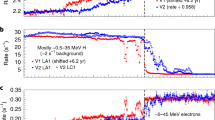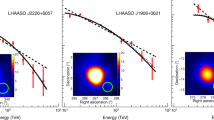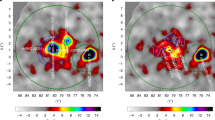Abstract
A RECENT communication from Legrand and Helary1 reports an increase in the total component of cosmic radiation at Paris on December 4, 1957. The increase amounted to about 18 per cent and extended over three hours with the maximum occurring at 2245 U.T. A small increase in the nucleonic component at Thule preceded the Paris event by about three hours. Optical and radio data indicate a flare of importance 1 on the western hemisphere of the Sun at 1657 U.T. (ref. 2).
This is a preview of subscription content, access via your institution
Access options
Subscribe to this journal
Receive 51 print issues and online access
$199.00 per year
only $3.90 per issue
Buy this article
- Purchase on Springer Link
- Instant access to full article PDF
Prices may be subject to local taxes which are calculated during checkout
Similar content being viewed by others
References
Legrand, J. P., and Helary, A., Nature, 187, 397 (1960).
Solar Geophysical Data, B (Jan. 1958).
Collins, C., and Jelly, D. H., Nature, 189, 128 (1961).
Cosmic Ray Intensity during the I.G.Y., No. 1 (Tokyo, March 1959).
Author information
Authors and Affiliations
Rights and permissions
About this article
Cite this article
WILSON, B. The Cosmic-Ray Observations of December 4, 1957. Nature 190, 615–616 (1961). https://doi.org/10.1038/190615b0
Issue Date:
DOI: https://doi.org/10.1038/190615b0
Comments
By submitting a comment you agree to abide by our Terms and Community Guidelines. If you find something abusive or that does not comply with our terms or guidelines please flag it as inappropriate.



